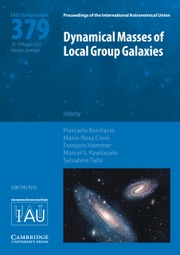No CrossRef data available.
Article contents
The Evolution of Galaxies and Groups in Cluster Environments at 0.3 < z < 0.6
Published online by Cambridge University Press: 01 August 2006
Extract
We investigate the dependence of galaxy populations on environment. Our samples are selected from the follow-up of Red-Sequence Cluster Survey (RCS) catalogs using wide-field BVRz' imaging for 60 intermediate redshift (0.3 < z < 0.6) clusters. Galaxy redshifts are estimated using an empirical photometric redshift technique with a training set of 3996 galaxies to z 1.4. To obtain photometric redshift probability density for each galaxy, we bootstrap the training set galaxies to estimate the fitting uncertainties and apply Monte-Carlo method to simulate galaxy magnitudes errors. In order to find galaxy groups using photometric redshift, we develop a modified friends-of-friends algorithm, ‘Probability Friends-of-Friends Algorithm (pFOF)’, where photometric redshift redshift probability densities of individual galaxies are used to determine member galaxies of a group. We calculate the red galaxy fraction to infer the evolutionary status of cluster galaxies and also for galaxies in groups selected in the same redshift space as the clusters.
Information
- Type
- Contributed Papers
- Information
- Proceedings of the International Astronomical Union , Volume 2 , Symposium S235: Galaxy Evolution Across the Hubble Time , August 2006 , pp. 220
- Copyright
- Copyright © International Astronomical Union 2007

